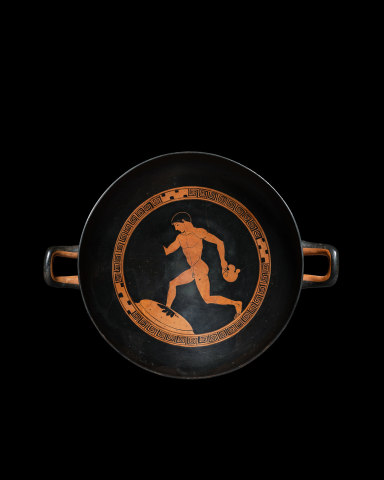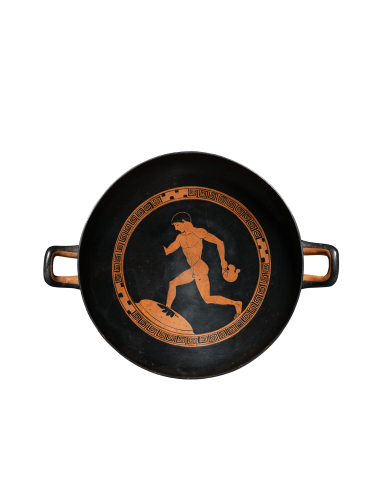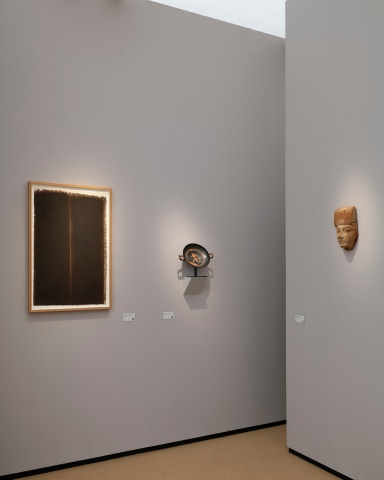Greek red-figure kylix, Athens, c.480 BC, attributed to the Cage Painter (Dyfri Williams)
Terracotta
Height: 9cm, diameter of rim: 23.7cm, width across handles: 31cm
11233
%3Cdiv%20class%3D%22title_and_year%22%3E%3Cem%3EGreek%20red-figure%20kylix%3C/em%3E%2C%20%3Cspan%20class%3D%22title_and_year_year%22%3EAthens%2C%20c.480%20BC%2C%20attributed%20to%20the%20Cage%20Painter%20%28Dyfri%20Williams%29%3C/span%3E%3C/div%3E%3Cdiv%20class%3D%22medium%22%3ETerracotta%3C/div%3E%3Cdiv%20class%3D%22dimensions%22%3EHeight%3A%209cm%2C%20diameter%20of%20rim%3A%2023.7cm%2C%20width%20across%20handles%3A%2031cm%3Cbr/%3E%0A%3C/div%3E
Finely potted Type B kylix, the tondo decorated with a nude youth running to the left. He is shown in profile, except for his torso which turns three-quarters toward the...
Finely potted Type B kylix, the tondo decorated with a nude youth running to the left. He is shown in profile, except for his torso which turns three-quarters toward the viewer. His lithe, muscular physique, with narrow waist and broad shoulders, is defined by finely drawn relief lines, whilst other muscles of his neck, limbs and abdomen are more subtly rendered in reddish dilute wash. In his left hand he carries a Chalcidean helmet, holding it by its nose guard, his right forearm and hand are missing. On the ground before him, obscuring his right foot, is a large circular shield, the convex centre decorated with a fig-leaf, and inscribed in faint letters: HO PAIS KALOS ‘the boy is beautiful’. The exterior is black except for selected reserved areas which include the roots and inner walls of the handles, the side and resting surface of the foot and its central roundel. The large tondo in the interior is framed by a band of stopped meanders, broken by four rectangular panels of black dentils. Restored from large fragments with some lacunae. The handle to the left of the boy running is recomposed with some sections made up. The right handle is entirely new.
The martial accoutrements identify the youth as an athlete, more specifically a hoplitodromos, who raced against others whilst carrying a shield and wearing a bronze helmet, usually of the Chalcidian type. For reasons we do not understand, fig leaves were a common device on shields carried by hoplitodromoi.
These cups proclaim the admiration of Athenian society for the young athletes whose competition, born of military training, was a prelude to their enrolment in the city’s armed militia.
The Cage Painter was an associate of the Antiphon Painter, though was not as prolific.
Provenance
Swiss art market by 13th December 1969
Dr Alfred Ebert, Franconia, Germany; acquired 2nd July 1971, thence by
descent
Literature
Compare contemporary cups by Onesimos at Harvard,
(published as Beazley archive number 203306), and in Basel
(ibid. 203307), the latter with a similarly inscribed shield
Publications
Münzen und Medaillen, Basel, Switzerland, Auktion 40,
Kunstwerke der Antike, 13th December 1969, lot 92
Münzen und Medaillen, Basel, Switzerland, Attische
Rotfigurige Vasen, May 1971, Sonderliste N, lot 78





